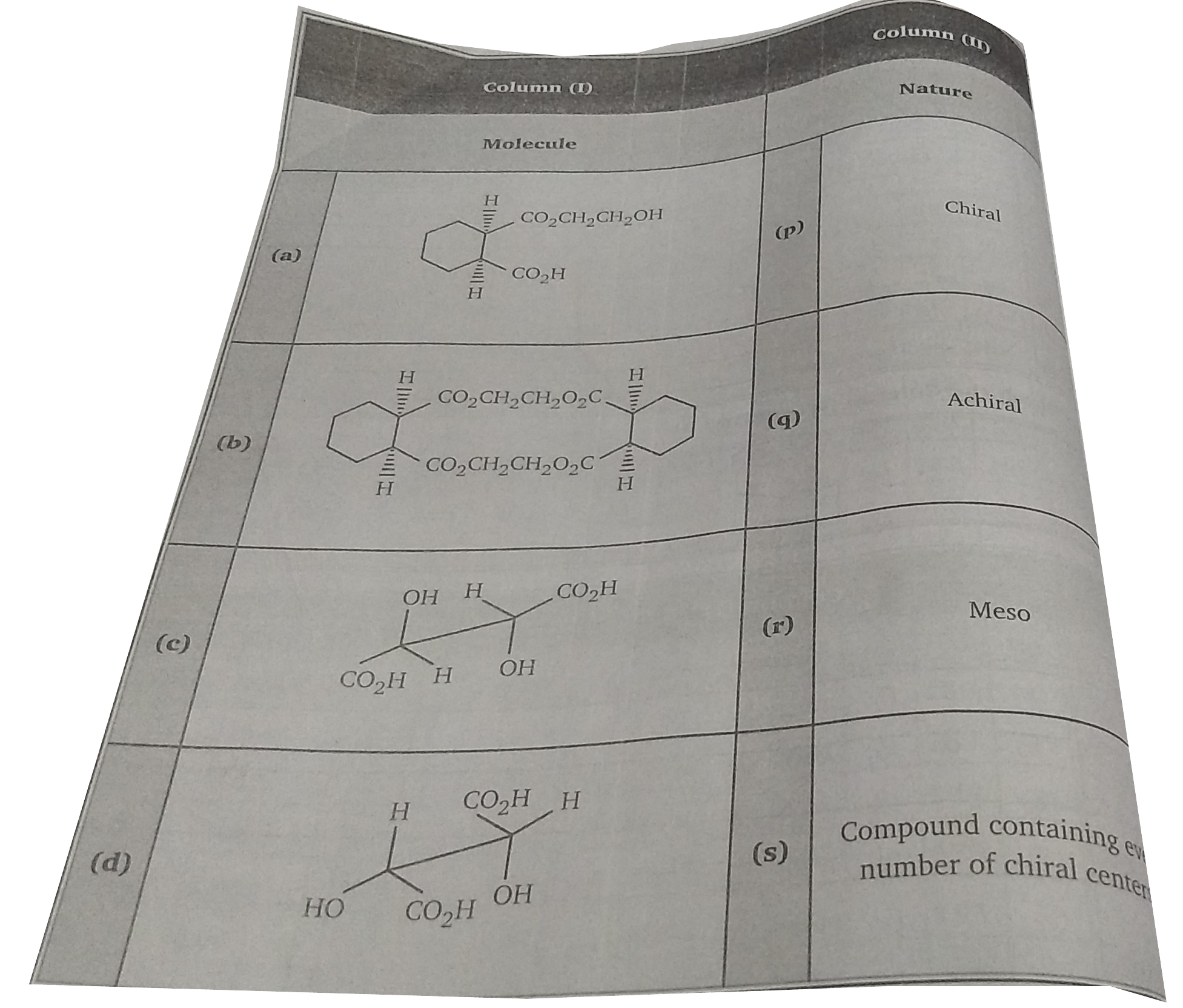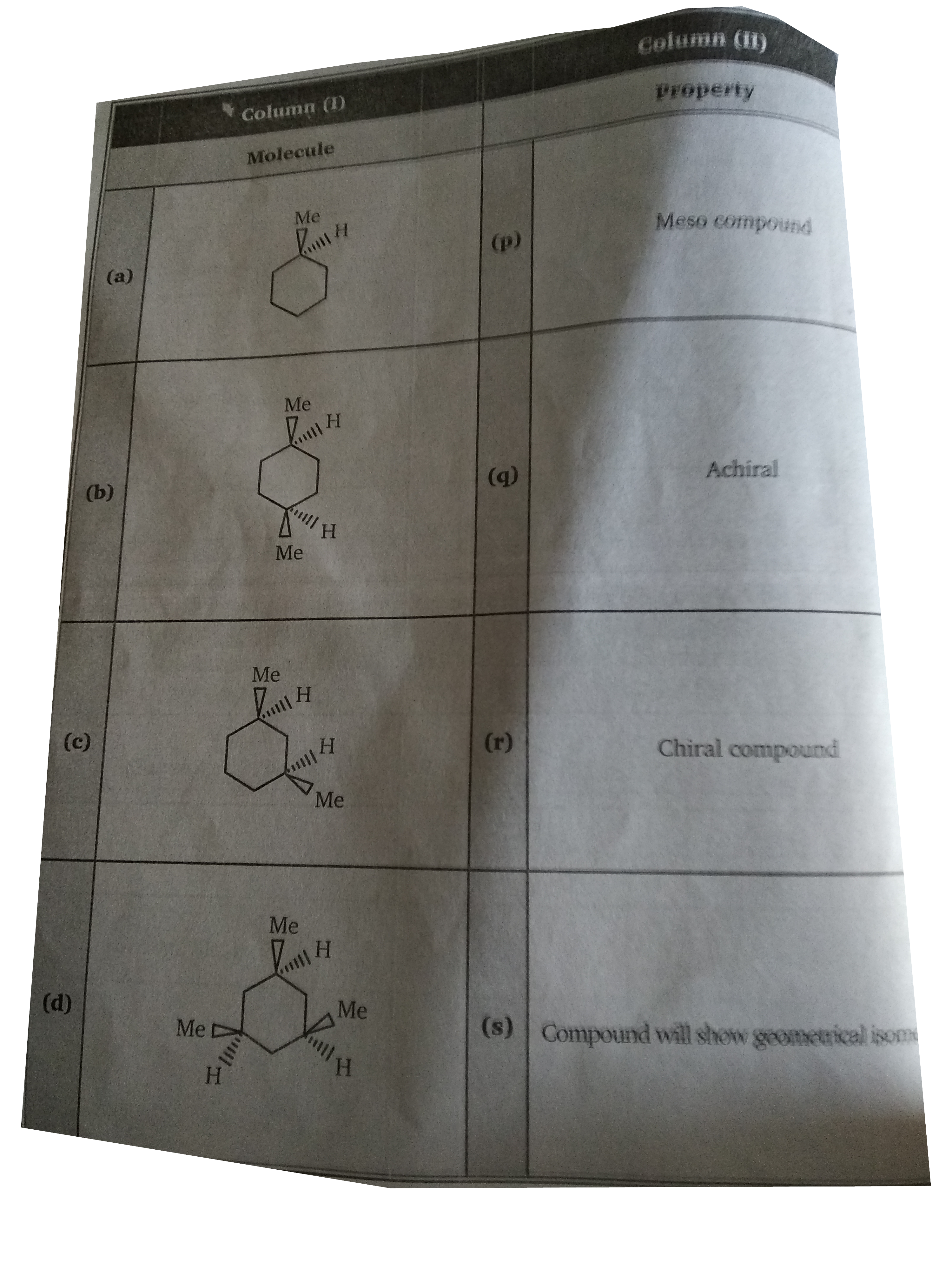Match the column I and II. (Matrix)
 Solution in Telugu
Solution in Telugu
Video Solution
Text Solution
The correct Answer is:a−p,r,s;b−q,r;c−q,r;d−p,r,s
As shown in fig. the relation of dipole moment to configuration is quite direct. If in a 1, 2 -disubstituted alkene (XCH = CHY) X and Y are both electron donating or both electron withdrawing, the dipole moment of the cis isomer will generally be sizeable, whereas that of the trans isomer will be small or zero (i.e. μcis>μtrans). If, on the other hand, X is electron donating and Y is electron withdrawing, or vice versa, .μtrans>μcis . In tribustituted alkenes XCH = CYZ the situation is less clear cut, though if Z is alkyl and X and Y are halogen or other strongly electron withdrawing groups, the disposition (cis or trans)

of X and Y will be decisive. Except for the case of cyclooctene, configuration can be inferred from dipole moment where known, though in some cases the differences are perhaps uncomfortably small. In the case of 1-chloro-2-iodoethylene the original, seemingly unreasonable order of dipole moments was later reversed. In trans-cyclooctene, the normal C2h symmetry of trans-XCH = CHX is reduced to at most C2, therefore the compound can have a dipole moment, whereas compounds of C2h symmetry cannot. That the moment is so large may be related to the highly twisted nature of the double bond (torsion angle between 136∘ and 157∘ )
Dipole Moments and the Dipole Rulea:
As for as the question is concerned, melting point of (trans > cis)because trans form is more symmetrical than cis form.
|
Topper's Solved these Questions
- GENERAL ORGANIC CHEMISTRY BOOK - MS CHOUHANCHAPTER - GENERAL ORGANIC CHEMISTRY EXERCISE - LEVEL - 2 (SUBJECTIVE PROBLEMS )
13 Videos
- GENERAL ORGANIC CHEMISTRY BOOK - MS CHOUHANCHAPTER - GENERAL ORGANIC CHEMISTRY EXERCISE - LEVEL - 2 (SUBJECTIVE PROBLEMS )
13 Videos
- CARBOXYLIC ACID AND THEIR DERIVATIVES BOOK - MS CHOUHANCHAPTER - CARBOXYLIC ACID AND THEIR DERIVATIVES EXERCISE - LEVEL-2( SUBJECTIVE PROBLEMS)
1 Videos
- GRIGNARD REAGENTBOOK - MS CHOUHANCHAPTER - GRIGNARD REAGENTEXERCISE - Level-2 (Subjective Problems)
6 Videos
Similar Questions
How many 2∘ carbon in the following ?

View SolutionHow many 2∘ carbon in the following ?

View Solution
(Y) is including stereoisomers. Value of (X+Y) will be
View Solution
How many geometrical isomer of (X) is possible ?
View SolutionMatch the column (I) and ((II). (Matrix)

View SolutionMatch the column (I) and (II) .(matrix)

View SolutionMatch the column I and II. (Matrix)

View SolutionMatch the Column (I) and (II). (Matrix)

View SolutionMatch the column (I) and (II). (Matrix)

View SolutionMatch the column (I) and (II). (Matrix)

View SolutionMatch the column (I) and (II). (Matrix)

View SolutionMatch the column (I) and (II). (Matrix)

View SolutionMatch the column (I) and (II). (Matrix)

View SolutionMatch the column (I) and (II). (Matrix)

View SolutionMatch the column (I) and (II). (Matrix)

View SolutionMatch the column I and II. (Matrix)

View Solution
